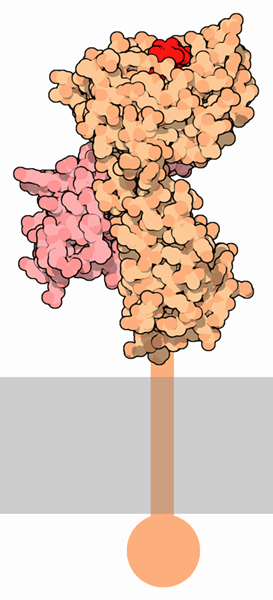|
Inhaltsübersicht | Nanomaschinen | Moleküle | Programme | Kurse | Fun | Links |
||
| > |
Major Histocompatibility Complex

Viruses are insidious enemies, so we must have numerous defenses against them. Antibodies are our first line of defense. Antibodies bind to viruses, mobilizing blood cells to destroy them. But what happens if viruses slip past this defense and get inside a cell? Then, antibodies have no way of finding them and the viruses are safe...but not quite.
Each cell has a second line of defense that it uses to signal to the immune system when something goes wrong inside. Cells continually break apart a few of their old, obsolete proteins and display the pieces on their surfaces. The small peptides are held in MHC, the major histocompatibility complex, which grips the peptides and allow the immune system to examine them. In this way, the immune system can monitor what is going on inside the cell. If all the peptides displayed on the cell surface are normal, the immune system leaves the cell alone. But if there is a virus multiplying inside the cell, many of the MHC molecules carry unusual peptides from viral proteins, and the immune system kills the cell.
Displaying Peptides
Like many proteins used in the immune system, MHC is composed of several functional parts connected by flexible joints. The structure shown here, PDB entry 1hsa, only shows the part found on the outside of the cell. The large chain colored orange has a groove at the top, which binds to the peptide, colored red. A smaller chain, colored pink, stabilizes the structure. In the whole protein, the orange chain extends down and crosses the cell membrane at the bottom, attaching the protein to the surface of the cell. This portion of the molecule, however, is too flexible for study by x-ray crystallography and was removed for the analysis.MHC in Action
Our itchy reaction to poison ivy is caused by the MHC system. The resins on poison ivy leaves react with proteins in the skin. These poisoned cells then break the proteins into pieces and display them using MHC molecules. The itchy rash is caused when the immune system attacks the problem. Even more serious, MHC is the cause of tissue rejection during skin grafts and organ grafts. This is how the protein got its name: the term histocompatibility refers to the difficulty of finding compatible grafts between a donor and a patient. Each person has their own collection of MHC molecules. There are hundreds of different kinds, but each person only has four types (two from each parent). If you graft a piece of skin that has a different collection of MHC types, they will trigger the immune system to destroy the cells. So the trick is to find a compatible donor, such as a relative, who has a similar collection of MHC molecules.The Cancer Connection
There is growing evidence that the MHC system is also important in the natural fight against cancer in your body. Cancer cells, like normal cells, display pieces of their own proteins on their surface. So, if any of these proteins carry recognizable cancer mutations, this provides a signal to the immune system that something is wrong.Next: Types and Terminology
Last changed by: A.Honegger,